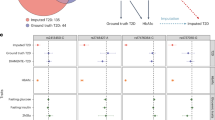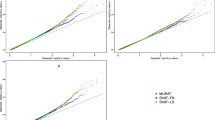Abstract
Haseman-Elston (H-E) regression is a commonly used conventional approach for detecting quantitative trait loci (QTLs), which regulate the quantitative phenotype based on the Identical-By-Descent (IBD) information between twins in Genome-wide scan. However, this approach only considers genetic effect at individual loci, but not any interaction between genes. A Pair-Wise H-E regression (PWH-E) and a Feature Screening Approach (FSA) are proposed in this paper to take gene-gene interaction into account when detecting QTLs. After testing these approaches with several series of simulation studies, they are applied to a real-world bone mineral density (BMD) dataset, and find three site specific sets of potential QTLs. Further comparison analyses show that our results not only corroborate the 14 findings from previous published studies, but also suggest 22 new QTLs of BMD.
Access this chapter
Tax calculation will be finalised at checkout
Purchases are for personal use only
Preview
Unable to display preview. Download preview PDF.
Similar content being viewed by others
References
Carrasquillo, M.M., et al.: Genome-wide association study and mouse model identify interaction between TET and EDNRB pathways in Hirschsprung disease. Nat. Genet. 32, 237–244 (2002)
Motsinger, A.A., Ritchie, M.D., Reif, D.M.: Novel methods for detecting epistasis in pharmacogenomics studies. Pharmacogenomics 8(9), 1229–1241 (2007)
Musani, S.K., et al.: Detection of gene x gene interactions in genome-wide association studies of human population data. Human Heredity 63(2), 67–84 (2007)
Elston, R.C., et al.: Haseman and Elston revisited. Genetic Epidemiology 19(1), 1–17 (2000)
Barber, M.J., et al.: Gamma regression improves Haseman-Elston and variance components linkage analysis for sib-pairs. Genetic Epidemiology 26(2), 97–107 (2004)
Haseman, J.K., Elston, R.C.: The investigation of linkage between a quantitative trait and a marker locus. Behavior Genetics 2(1), 3–19 (1972)
Sham, P.C., et al.: Powerful regression-based quantitative-trait linkage analysis of general pedigrees. The American Journal of Human Genetics 71(2), 238–253 (2002)
Hall, M.A.: Correlation-based feature selection of discrete and numeric class machine learning (2000)
Gütlein, M., et al.: Large-scale attribute selection using wrappers (2009)
Masters, T.: Practical neural network recipes in C++. Morgan Kaufmann, San Francisco (1993)
Montano, J.J., Palmer, A.: Numeric sensitivity analysis applied to feedforward neural networks. Neural Computing & Applications 12(2), 119–125 (2003)
Matchenko-Shimko, N., Dube, M.P.: Gene-Gene Interaction Tests Using SVM and Neural Network Modeling. In: CIBCB (2007)
Thomas, D.C.: Statistical Methods in Genetic Epidemiology. Oxford University Press, Oxford (2004)
Kaufman, J.M., et al.: Genome-wide linkage screen of bone mineral density (BMD) in European pedigrees ascertained through a male relative with low BMD values: evidence for quantitative trait loci on 17q21-23, 11q12-13, 13q12-14, and 22q11. Journal of Clinical Endocrinology & Metabolism 93(10), 3755 (2008)
Richards, J.B., et al.: Bone mineral density, osteoporosis, and osteoporotic fractures: a genome-wide association study. The Lancet (2008)
Rivadeneira, F., et al.: Twenty loci associated with bone mineral density identified by large-scale meta-analysis of genome-wide association datasets. Bone 44, 230–231 (2009)
Koller, D.L., et al.: Genome-Wide Association Study of Bone Mineral Density in Premenopausal European-American Women and Replication in African-American Women. Journal of Clinical Endocrinology & Metabolism
Styrkarsdottir, U., et al.: Multiple genetic loci for bone mineral density and fractures. New England Journal of Medicine 358(22), 2355 (2008)
Zhang, F., et al.: A whole genome linkage scan for QTLs underlying peak bone mineral density. Osteoporosis International 19(3), 303–310 (2008)
Wilson, S.G., et al.: Comparison of genome screens for two independent cohorts provides replication of suggestive linkage of bone mineral density to 3p21 and 1p36. The American Journal of Human Genetics 72(1), 144–155 (2003)
Author information
Authors and Affiliations
Editor information
Editors and Affiliations
Rights and permissions
Copyright information
© 2011 Springer-Verlag Berlin Heidelberg
About this paper
Cite this paper
Li, Q., MacGregor, A.J., Wang, W. (2011). Novel Data Mining Approaches for Detecting Quantitative Trait Loci of Bone Mineral Density in Genome-Wide Linkage Analysis. In: Yin, H., Wang, W., Rayward-Smith, V. (eds) Intelligent Data Engineering and Automated Learning - IDEAL 2011. IDEAL 2011. Lecture Notes in Computer Science, vol 6936. Springer, Berlin, Heidelberg. https://doi.org/10.1007/978-3-642-23878-9_59
Download citation
DOI: https://doi.org/10.1007/978-3-642-23878-9_59
Publisher Name: Springer, Berlin, Heidelberg
Print ISBN: 978-3-642-23877-2
Online ISBN: 978-3-642-23878-9
eBook Packages: Computer ScienceComputer Science (R0)




